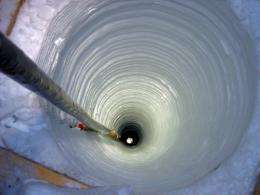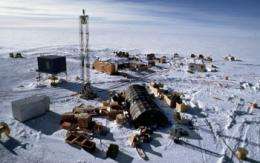Frozen secrets of the 'Ice Cube'

There's nothing like temperatures that can reach minus 100 degrees Fahrenheit to keep you on your toes.
For engineers Erik Verhagen and Camille Parisel, working in Antarctica on a project appropriately called "IceCube" is both challenging and exciting.
While there are ways to get used to the harsh climate, these experts have to be very resourceful to fix technical difficulties so far away from "civilization."
"Whatever the problems are," says Parisel, "you have to do it yourself, you can't call and say, 'Well, help me, I don't know how to do that.' Sometimes you don't even have the Internet. We work together to fix problems; we try to make it work and we help each other."
"Sometimes it happens that you are short of something, and you are creative, [so] you build it yourself. That's how you resolve problems," adds Verhagen.
Parisel and Verhagen are among about 250 people around the globe who work on one of the most unusual observatories on our planet.
What is IceCube?
The IceCube Neutrino Observatory is a collection of thousands of sensors, buried up to a mile and a half below the surface of the Antarctic, designed to study neutrinos. Neutrinos are mysterious, subatomic particles that have very little mass, and only interact weakly with other particles.
Neutrinos are emitted by violent cosmic events, such as supernovas or black holes. Why are they so important? Tracing their origin could provide clues in the search for dark matter and other secrets of our universe.

So what was the first reaction when University of Wisconsin physics professor Francis Halzen proposed this one kilometer cube of detectors, buried in the harshest environment on Earth?
"They all think we are crazy," laughs Halzen from IceCube headquarters in Madison, Wis.
But putting this observatory (a telescope that looks within the Earth instead of out at the sky), in the crystal clear ice below the South Pole started making more and more sense.
With support from the National Science Foundation (NSF), Halzen and his team in Madison, plus other physicists and researchers around the world, got the search for this mysterious, ghostly particle going.
"They are very difficult to catch," says Halzen. "They are just like light; there is basically no difference between neutrinos and light. The only difference is that light doesn't go through a wall whereas neutrinos go through everything. And so just accidentally, they run straight into the nucleus of an atom and then create lots of other particles, which we can see and it's only these accidental crashes of neutrinos that allow us to observe them. That's basically what IceCube is doing."
When a neutrino does collide with an atom of ice, that collision produces a particle called a muon. In the transparent Antarctic ice, the muon radiates blue light, which is what IceCube's optical sensors detect.
At least a couple of times during the early going--after the first season of drilling in 2004-2005, Halzen feared that the logistics were just too daunting.
"IceCube, I always say, [had] two challenges," explains Halzen. "One challenge was to make the ice work; to understand the ice and to turn it into a particle physics detector. The other challenge, equally big, was to drill these holes. That came from the knowledge of these engineers."
"Hot water drilling is an art. It is an incredible art; almost not a science, almost not engineering," he says. "It's just difficult; it's a choreography, which has to work perfectly, and the people learned this very fast."
IceCube will be completed during the 2010-2011 Antarctic summer, (beginning in November 2010), the last of 86 strings of sensors will be lowered into the ice and frozen in place. Each string (actually very heavy cable) includes 64 Digital Optical Modules (DOMs).
IceCube mechanical engineer Terry Benson has traveled to Antarctica five times to install the basketball-sized DOMs.
"On the bottom there is a photo multiplier tube and it is basically a light bulb in reverse, so it picks up light and sends an electrical signal to this top section, which is basically a high powered computer," explains Benson.
Being buried more than a mile below the ice means there is no chance of retrieving a DOM with a glitch to try and repair it. That's why the sensors undergo a lot of tests at the IceCube engineering facility in Stoughton, Wis., before they are shipped off to their very permanent homes.
"So they need first to be able to maintain extreme pressures in the water-filled bore hole when we put them in," says Benson. "Once the hole freezes back, there is intense pressure there as well. These ultimately get tested to 10,000 psi."
"Once they are frozen back in the ice, they get hooked up to our central gathering spot of data. There're onboard computers here that can be maintained from above the surface, and software and firmware updates can be done without ever accessing these," says Benson, who has worked on IceCube since he was a student in 2003.
Scientific Surprises
Ever since the very first string of DOMs started its detection, physicists have been collecting data on neutrinos. And, as sometimes happens in basic scientific research, there are discoveries that are unanticipated. That's what's happened with the work of Rasha Abbasi, a post doctoral physicist on the IceCube project.
While others concentrated on the neutrinos, Abbasi took a closer look at the mountains of other raw data coming in; the particles constantly bombarding IceCube, generated by cosmic rays.
"The cosmic rays that I looked at are mostly the background for other researchers, that are looking for neutrinos, which is what IceCube was built for," says Abbasi.
"This background is like billions of events that are coming downward on IceCube."
What did she find?
Abbasi created a "skymap" of all the data IceCube was collecting, and discovered an unusual pattern in the intensity of cosmic rays directed toward the Earth's Southern Hemisphere. There was an excess in rays detected in one part of the sky and a deficit in the other.
"So that if they were all coming in the same intensity from all the sky, we would call that isotropic. And if they would come from one direction more than another direction, we would call that anisotropy," explains Abbasi.
It's the first time such "lopsidedness" has been detected in the Southern Hemisphere. According to Abbasi, the unusual pattern could be due to a magnetic field surrounding Earth, or the effect of a nearby supernova remnant.
This finding is a true delight to Halzen, as a physicist and a teacher--learning about phenomenon the telescope was not even designed to study.
"We already have one beautiful example of a totally serendipitous discovery," he says.
Along with the pioneering science in the search for neutrinos, Halzen says it is the perfect topic to get just about anyone interested in scientific research.
"This is an ideal project for outreach, of course. The combination of studying the universe with this mysterious particle and doing it in this unfriendly environment, it's just the right combination to get kids of all ages interested," says Halzen. "Whether it is in a classroom or an audience of adults, it is always a pleasure because it is so easy to get people excited about it."
And, for those on the project like Parisel and Verhagen, who spend months in the darkness of the Antarctic winter with just a few dozen other people, the project also creates a lifelong camaraderie.
"After nine months of being completely isolated, it's your family. It's as strong as your own family, and I have a family forever," says Verhagen.
More information:
Learn more in this special report: www.nsf.gov/news/special_repor … ole/sciencegoals.jsp
And in this discovery: www.nsf.gov/discoveries/disc_s … m.jsp?cntn_id=100173
Provided by National Science Foundation


















